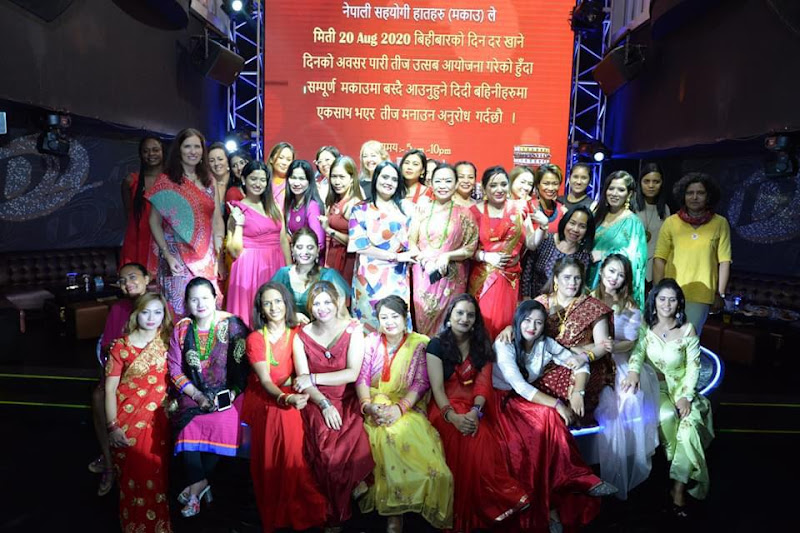The Origin and Evolution of the Teej Festival
Origin of teej Festival
भगवानलाई भेटन के के पाउर चाहिन्छ त्यति सम्चार ल्याइदिए,
पहिलेमा चाहिन्छ श्रीखण्ड चन्दन दुसरी बेलपत्र नि वरिलै नि वरिलै दुसरी बेलपत्र ।
"Where to go to meet the divine at Dhukur Chari Golyan,
To meet the divine, what offerings are needed, gather that much information.
After the establishment of Radio Nepal in 2007, a language and culture from one place have spread to other places as well. Even those who cannot compose and sing songs themselves can enjoy entertainment through the medium of songs broadcasted by Radio Nepal. In the subsequent album, a slight modification in the song narrates the story of a daughter-in-law who, after a little change in the song, expressed the pain she felt at home.
The internal and external situations are like the wide jaws of Nandadevi, and just as an arrow cannot penetrate a dried wooden log, the mother's tears cannot be held back.
भित्र बाहिर नन्द देवर विरालुका छाउरा झैं, खान खुट्न छैन आमा सुकें दाउरा झैं ।
In addition, the Gandharva community used the medium of the sarangi to sing about the events that occurred in society. Songs like these were composed and sung.
The song is about an incident that occurred in the market of Pokhara. It narrates the story of a girl going to Maiti and encountering some unusual events. The lyrics depict the changes in society, highlighting the transformation in values and perspectives. The father mentions that his daughter has become like his own, while the in-laws focus on the daughter-in-law's jewelry. This change in society is expressed through the medium of the song.
The song also refers to the political changes in the country, with King Virrendra enforcing family planning. It contrasts traditional practices like cooking rice in a mud pot and the difficulty in using cement for construction. The lyrics also mention the influence of time on people's behavior, with fake imitations becoming prevalent.
During the Teej festival, various places used to have fairs, and young girls would sing songs while young boys observed. The lyrics touch upon the traditional practice of tying a red scarf around a girl's neck, symbolizing acceptance of marriage proposals. The song "Pachhyauri Leu Baina" conveys these messages through its lyrics.
In recent times, Teej songs have become more commercialized and have lost some of their traditional essence. Pashupati Sharma, a popular artist, criticized the commercialization of Teej songs, expressing concern about the diminishing authenticity of the festival's music.
The narrative shifts to a dispute between two young men from different villages during the year 2041. With the establishment of Nepal Television, Teej songs started being broadcasted with audio and video elements. Music Nepal, a music company, played a significant role in bringing Teej songs to the market through cassette albums. With the advent of cassette players, Teej songs became more accessible.
However, in recent times, Teej songs have faced criticism for becoming too commercialized and deviating from the traditional essence. Pashupati Sharma, a renowned artist, has been a vocal critic of the commercialization of Teej songs.
The latter part of the text discusses the changes in the Teej fasting process, starting a month before the festival. The tradition of consuming Poshilo Khane Kuraa (traditional dishes) was prevalent, but with the influence of modernization, this practice was restricted. The government imposed a ban on celebrating Teej in party palaces, and the celebration moved to homes.
In rural areas, Teej was celebrated by preparing special dishes like Chiura, Lattes, and Chamre on the day of the festival. Special rituals, such as offering Chichindo and Farsi to Teej, were observed. The tradition of Dar Khane also saw changes, with more emphasis on hunting for special food items like Ghiraula.
The text then reflects on the impact of the COVID-19 pandemic on Teej celebrations in 2077. Due to the pandemic, many Nepali women were unable to go to their maternal homes to celebrate Teej. However, they found creative ways to celebrate through live videos on Facebook, sharing photos and videos of their Teej celebrations.
The celebration in Macau during the same year was unique, with Nepali expatriates coming together to celebrate virtually, showcasing cultural performances through dance and music. This demonstrated how the festival continued to be celebrated despite the challenges posed by the pandemic.
In conclusion, the text emphasizes the importance of preserving cultural traditions and celebrating festivals like Teej. It highlights the adaptability of Nepali communities in the face of changing circumstances, such as the COVID-19 pandemic, and the significance of maintaining cultural connections even in foreign lands.







Comments
Post a Comment